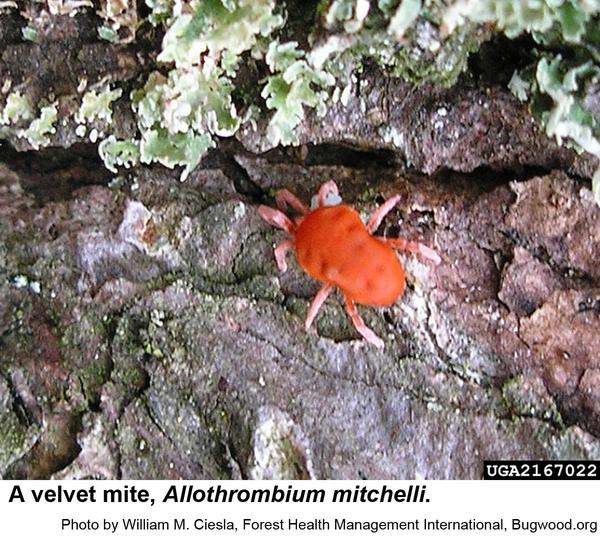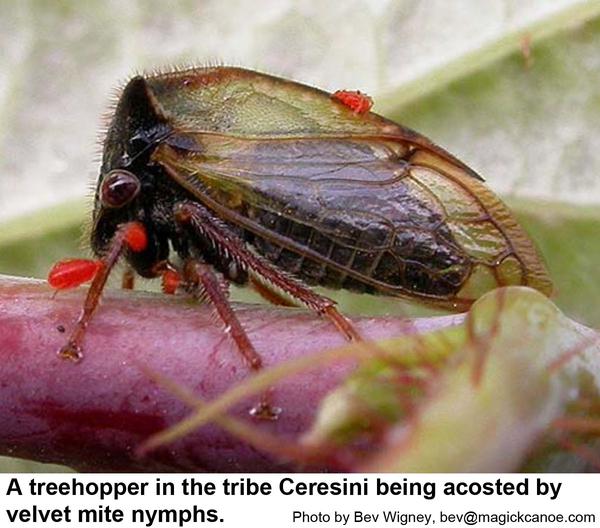Description and Biology
Trombidiid mites are called velvet mites, red velvet mites, large red velvet mites, brick mites, and patio mites. Most of the year they are commonly found in soil and litter on top of the ground. In spring, adult velvet mites are often observed scurrying around on patios, brick walls, and other objects as they seek insects and insect eggs to feed upon. Eggs are laid in the soil during March through July and hatch after 1 to 2 months depending on the environmental conditions. Eggs develop normally at 100 % relative humidity. Below 80 % relative humidity eggs do not survive. From eggs hatch larvae, extremely small, six-legged animals that feed on insects as external parasites. Larvae feed for a week or two and then detach from the host and move into the soil. The next stage (protonymph) develops within the skin of larval stage. A second nymph stage (deutonymph) emerges during the summer or autumn and forages on the soil surface and plants for insects on which to feed. The next stage (tritonymph) develops within the skin of the deutonymph in the soil, and adults emerge in the autumn. Nymphs that appear late in summer or autumn may fail to mature in the same year and complete their life cycle in the second or even third year. Adults usually hibernate in the soil during the winter. Some species lay eggs in autumn. Depending on the species involved, 6 to 10 months elapse from newly-laid eggs to new adults. We have one generation (or a partial generation) per year in North Carolina.
Hosts
Velvet mite larvae are parasitic on insects and other invertebrates. Older stages are predators of small arthropods. Because their prey and hosts include insect and mite pests of economic importance, these mites are considered to have potential as biological control agents!
Residential Recommendations
No pesticide is labeled for velvet mites. It's a pretty sure bet that the pyrethroid bifenthrin will kill them. When used as directed, pyrethroids are very toxic to insects but are not particularly hazardous to humans and pets (other than fish—avoid using pyrethroids around pools, ponds, and streams). Bifenthrin is the active ingredient of several insecticide formulations labeled for residential landscapes found in the garden sections of big box stores. (The active ingredient is listed on the front of every pesticide label usually in very small font near the bottom.) As long as one treats to kill one of the pests on the label, it is not illegal to use bifenthrin in the landscape. The mites would be killed as you treat to prevent damage by Japanese beetles or some other pest. If the bifenthrin drifted onto a patio, there would be pesticide residue on the patio that could be tracked into the house, and there would be some odor involved. We recommend using a garden hose to wash the mites away or using soapy water to kill the mites but not leave a toxic residue.
Other Resources
- Review, Biology and ecology of trombidiid mites (Acari: Trombidioidea). Zhi-Qiang Zhang, Zhi-Quiang. 1998. Experimental & Applied Acarology, 22: 139–155.
- What Are Mites? The Red Velvet Mite (Trombidiidae). livingsta. 2020 (update). Owlcation.
- Extension Plant Pathology Publications and Factsheets
- Horticultural Science Publications
- North Carolina Agricultural Chemicals Manual
For assistance with a specific problem, contact your local N.C. Cooperative Extension Center.
This Factsheet has not been peer reviewed.
Publication date: May 2, 2020
Reviewed/Revised: March 6, 2025
Recommendations for the use of agricultural chemicals are included in this publication as a convenience to the reader. The use of brand names and any mention or listing of commercial products or services in this publication does not imply endorsement by NC State University or N.C. A&T State University nor discrimination against similar products or services not mentioned. Individuals who use agricultural chemicals are responsible for ensuring that the intended use complies with current regulations and conforms to the product label. Be sure to obtain current information about usage regulations and examine a current product label before applying any chemical. For assistance, contact your local N.C. Cooperative Extension county center.
N.C. Cooperative Extension prohibits discrimination and harassment regardless of age, color, disability, family and marital status, gender identity, national origin, political beliefs, race, religion, sex (including pregnancy), sexual orientation and veteran status.




